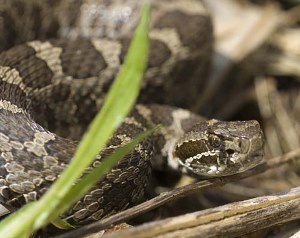This time of year, as snakes are out and about in the great outdoors, the Department of Natural Resources gets many questions about Michigan’s snakes. Michigan is home to 18 different species of snakes, 17 of which are harmless to humans. T
here are two that are very similar and often cause a stir when people encounter them. Eastern hognose snakes, when threatened, puff up with air, flatten their necks and bodies, and hiss loudly. (This has led to local names like “puff adder” or “hissing viper.”) If this act is unsuccessful in deterring predators, the snakes will writhe about, excrete a foul-smelling musk and then turn over with mouth agape and lie still, as though dead. Despite this intimidating behavior, hog-nosed snakes are harmless to humans.
 The eastern massasauga rattlesnake, the only venomous snake species found in Michigan, is quite rare and protected as a species of special concern due to declining populations from habitat loss. As the name implies, the massasauga rattlesnake does have a segmented rattle on its tail. It should not be confused with the other harmless species of snake in Michigan that do not have segmented rattles but also will buzz their tails if approached or handled.
The eastern massasauga rattlesnake, the only venomous snake species found in Michigan, is quite rare and protected as a species of special concern due to declining populations from habitat loss. As the name implies, the massasauga rattlesnake does have a segmented rattle on its tail. It should not be confused with the other harmless species of snake in Michigan that do not have segmented rattles but also will buzz their tails if approached or handled.
Eastern massasauga rattlesnakes are shy creatures that avoid humans whenever possible. Also known as “swamp rattlers,” they spend the vast majority of their time in year-round wetlands hunting their primary prey, mice. When encountered, if the snake doesn’t feel threatened, it will let people pass without revealing its location. If humans do get too close, a rattlesnake will generally warn of its presence by rattling its tail while people are still several feet away. If given room, the snake will slither away into nearby brush.
Rattlesnake bites, while extremely rare in Michigan (fewer than one per year), can and do occur. Anyone who is bitten should seek medical attention immediately. To learn more about the massasauga and for more snake safety tips, visit http://mnfi.anr.msu.edu/emr/index.cfm. Read more
 The Kirtland’s warbler is one of the rarest members of the wood warbler family. The only places on Earth it currently nests are mainly in Michigan’s northern Lower and Upper peninsulas, and a few locations in Wisconsin and the province of Ontario.
The Kirtland’s warbler is one of the rarest members of the wood warbler family. The only places on Earth it currently nests are mainly in Michigan’s northern Lower and Upper peninsulas, and a few locations in Wisconsin and the province of Ontario.
 Chronic wasting disease is an unusual neurological disorder that affects members of the deer family. CWD is caused by prions – mutating proteins in the animal’s nervous system – not a bacteria or virus. A form of transmissible spongiform encephalopathy, similar to mad cow disease, CWD causes lesions in the brain. Infected animals exhibit uncharacteristic behavior – they lose their fear of humans, for instance – and gradually waste away. CWD has never been shown to cause illness in humans.
Chronic wasting disease is an unusual neurological disorder that affects members of the deer family. CWD is caused by prions – mutating proteins in the animal’s nervous system – not a bacteria or virus. A form of transmissible spongiform encephalopathy, similar to mad cow disease, CWD causes lesions in the brain. Infected animals exhibit uncharacteristic behavior – they lose their fear of humans, for instance – and gradually waste away. CWD has never been shown to cause illness in humans. 


 The
The 
